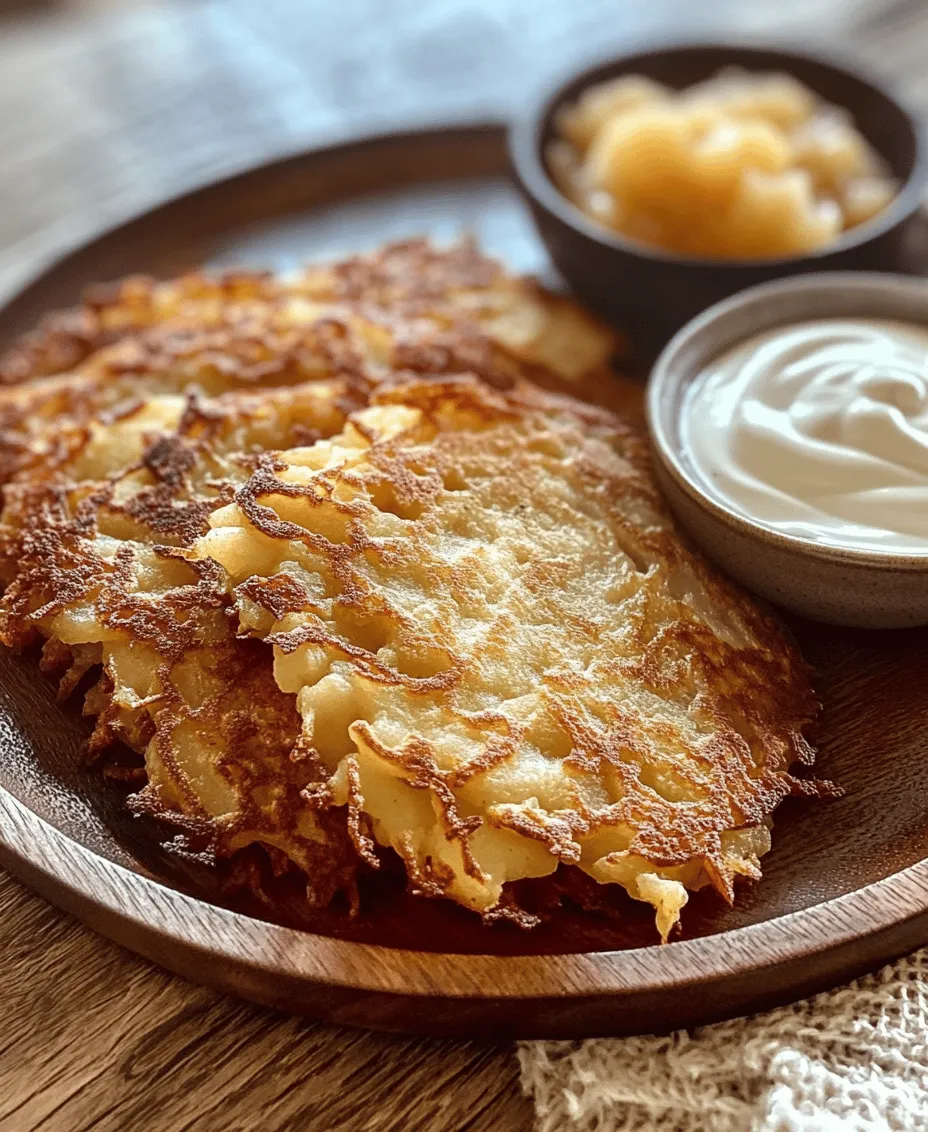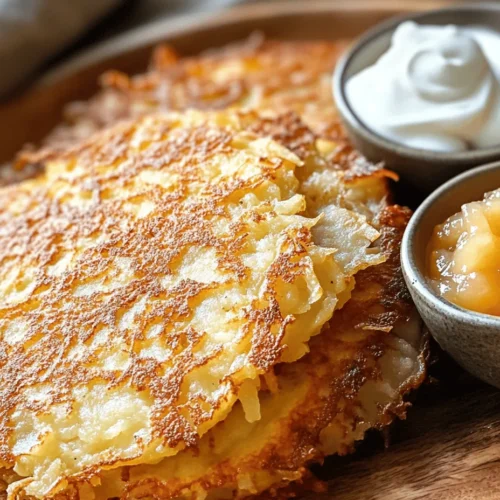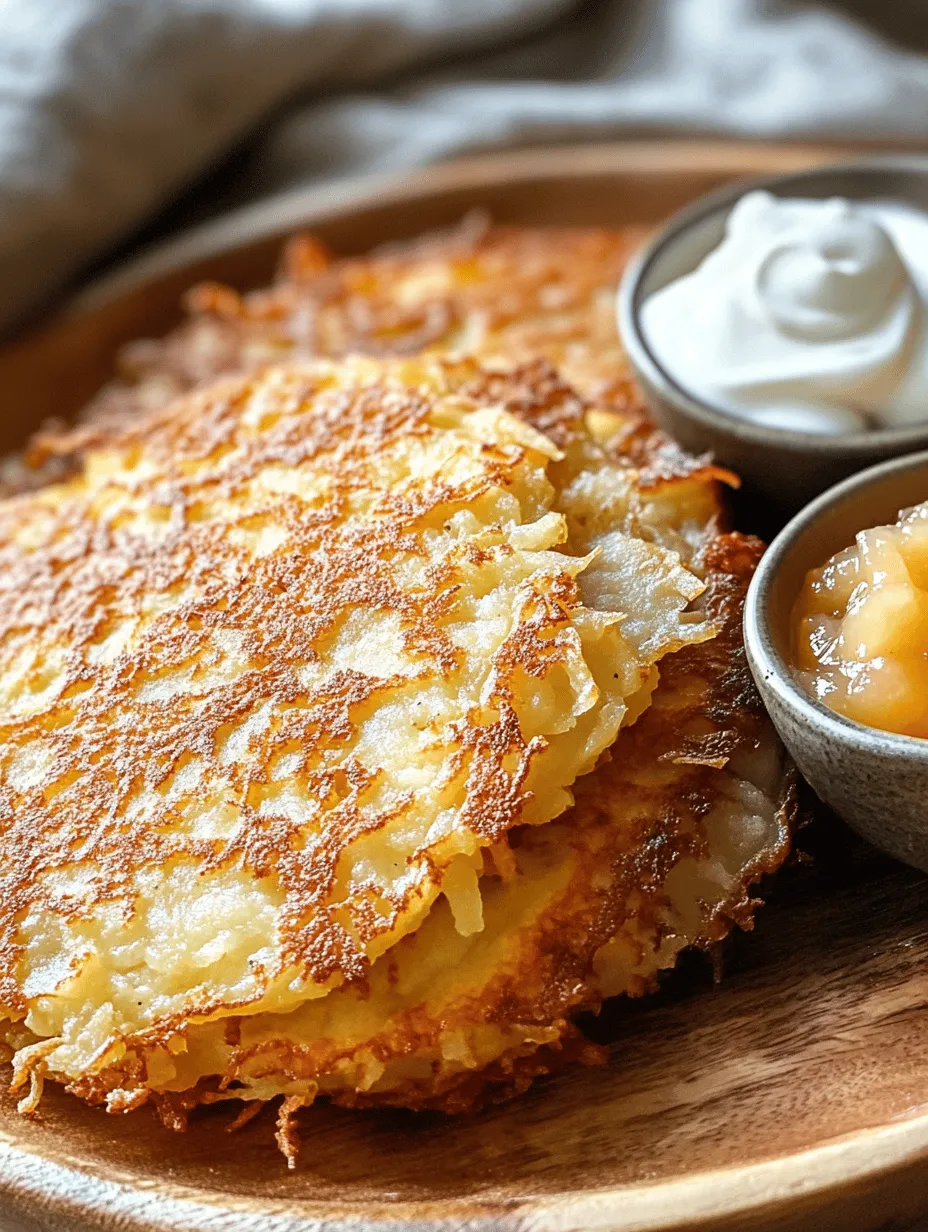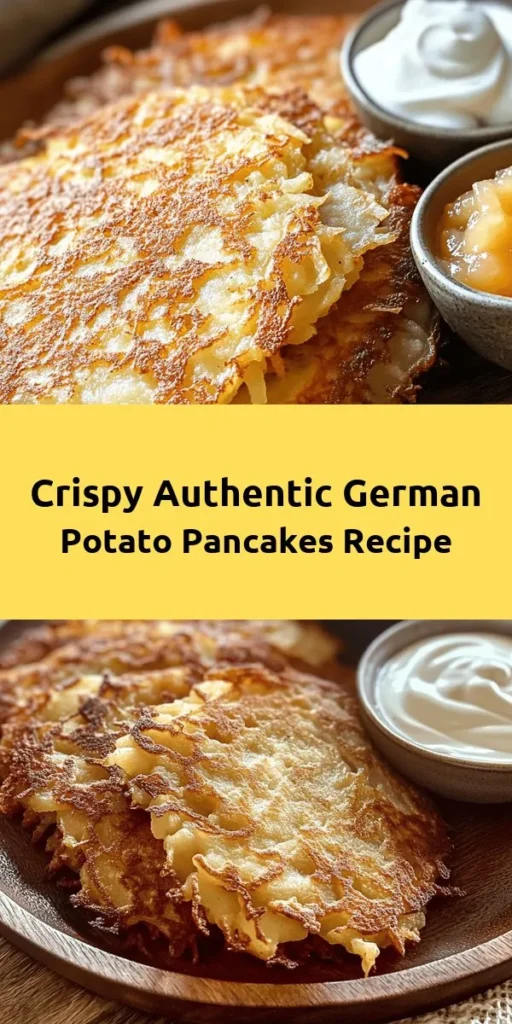Introduction
German potato pancakes, known as “Reibekuchen” or “Kartoffelpuffer,” are a beloved staple in German cuisine, celebrated for their crispy exterior and tender interior. These savory delights have transcended generations, becoming a symbol of comfort and home-cooked meals across Germany. Their cultural significance is deeply rooted in the country’s agricultural history, where potatoes played a crucial role in the diet of rural communities. Today, potato pancakes are not only a favorite during the festive season but also a popular dish enjoyed year-round, often served at fairs and local markets.
What makes this recipe so appealing is its authenticity and simplicity. With just a handful of basic ingredients, anyone can whip up a batch of these delectable pancakes in no time. The beauty of German potato pancakes lies in their versatility; they can be paired with a variety of accompaniments, such as sweet applesauce or tangy sour cream, elevating the dish while allowing personal preferences to shine through. Whether you’re aiming to impress guests or simply satisfy a craving for comfort food, these pancakes are bound to please.
Understanding German Potato Pancakes
Potato pancakes have a rich historical context within German cuisine that dates back centuries. The dish is thought to have originated in the regions where potatoes were cultivated extensively, allowing families to utilize this versatile tuber in a variety of ways. Traditionally, potato pancakes were prepared during harvest time as a means to make use of the fresh produce available.
Throughout Germany, variations of potato pancakes exist, each with its unique twist that reflects local tastes and traditions. In the Rhineland, for example, the pancakes are often made with grated potatoes combined with onions and flour, resulting in a slightly thicker consistency. In contrast, the Bavarian version tends to be lighter and crispier, thanks to its preparation method and the addition of eggs. Regardless of the regional variation, one thing remains constant: potato pancakes are a cherished dish that brings people together around the table.
These crispy delights often feature prominently in traditional German meals and celebrations. Whether it’s at Christmas markets, where vendors serve hot potato pancakes alongside apple compote, or during family gatherings, they are a dish that evokes nostalgia and warmth. The act of sharing potato pancakes has become synonymous with camaraderie and festivity, making them not just a dish to enjoy but an experience to cherish.
Ingredients Breakdown
To create authentic German potato pancakes, it’s essential to select the right ingredients to ensure the best flavor and texture. Here’s a closer look at each component of the recipe:
1. Russet Potatoes
The star ingredient of this recipe is the russet potato. Known for their high starch content, russets are ideal for making potato pancakes as they yield a fluffy interior while allowing for a perfectly crispy outer layer. When selecting potatoes, look for ones that are firm and free from blemishes. The starchiness of russet potatoes helps in binding the mixture together without the need for excessive flour, which is crucial for achieving that quintessential pancake texture.
2. Onion
Onion plays a pivotal role in enhancing the flavor of potato pancakes. Whether you choose to use a yellow or sweet onion, the grated onion adds a subtle sweetness and depth to the dish. When mixed with the potatoes, onions release moisture, which contributes to the pancakes’ overall texture. For an extra punch of flavor, consider sautéing the onions lightly before adding them to the mixture.
3. Eggs
Eggs serve as a binding agent in the potato pancake mixture, helping to hold the grated potatoes and other ingredients together. They add richness and contribute to the overall moisture of the pancakes. Be sure to use fresh eggs for the best results, as they improve both flavor and texture.
4. Flour
Flour is another binding ingredient that plays a crucial role in ensuring the pancakes hold their shape while frying. It helps to absorb excess moisture and provides a little structure to the mixture. While all-purpose flour is commonly used, you can experiment with alternatives like potato flour or gluten-free flour if you prefer a gluten-free option.
5. Seasoning with Salt and Pepper
Seasoning is key to enhancing the natural flavors of the ingredients. A generous pinch of salt not only brings out the taste of the potatoes but also helps to draw out excess moisture. Freshly cracked pepper adds a touch of warmth and spice. Adjust the seasoning to your personal preference, keeping in mind that the pancakes will be served with additional toppings that may also contribute to the overall flavor profile.
6. Vegetable Oil
The choice of oil for frying can significantly affect the flavor and crispiness of the pancakes. Neutral oils like canola, vegetable, or sunflower oil are ideal as they won’t overpower the taste of the pancakes. It’s essential to use enough oil to create a shallow fry, which helps achieve that golden-brown crust we all love. For those seeking a more authentic flavor, consider using clarified butter or lard for frying.
Preparation Steps for Perfect Potato Pancakes
Achieving the perfect potato pancake requires careful preparation and attention to detail. Here are the initial steps to ensure your pancakes turn out crispy and delicious.
Emphasizing the Importance of Potato Preparation
Before diving into the mixing process, proper preparation of the potatoes is crucial. Start by peeling the russet potatoes and rinsing them under cold water to remove any dirt. Once clean, the next step is to grate the potatoes using a box grater or a food processor. This method creates the fine shreds that contribute to the texture of the pancakes.
Squeezing Out Excess Liquid
One of the most critical steps in preparing potato pancakes is removing excess moisture from the grated potatoes. After grating, transfer the potatoes to a clean kitchen towel or cheesecloth. Gather the edges of the towel and twist, squeezing out as much liquid as possible. This step is vital because excess moisture can lead to soggy pancakes rather than the crispy, golden-brown treats we desire. The drier the potato mixture, the better the texture will be.
Combining Ingredients: Achieving the Right Consistency
Once the potatoes are adequately prepared, it’s time to combine all the ingredients. In a large mixing bowl, combine the grated potatoes and grated onion. Add in the eggs, flour, and a generous sprinkle of salt and pepper. Using a spatula or your hands, gently mix the ingredients until everything is evenly incorporated. The mixture should be thick enough to hold together but not overly dry.
When mixing, be careful not to overwork the batter. The goal is to keep some of the air in the mixture to ensure fluffy pancakes. If the mixture feels too dry, you can add a little more egg or a splash of water to achieve the right consistency. Conversely, if it feels too wet, a bit more flour can help bind it.
As you move through these preparation steps, keep in mind that the quality of your ingredients and the attention to detail in your technique will greatly influence the final result. With the right approach, you’ll be well on your way to creating authentic German potato pancakes that are sure to impress your family and friends.
Stay tuned for the next part of this recipe, where we will explore the frying techniques and serving suggestions that will elevate your potato pancakes to the next level.

Heating the Oil: Temperature Control for Optimal Frying
Frying the perfect potato pancakes requires careful attention to oil temperature. The ideal frying temperature is between 350°F to 375°F (175°C to 190°C). If the oil is too hot, the pancakes may burn on the outside while remaining raw inside. Conversely, if the oil is not hot enough, the pancakes will absorb too much oil and become greasy rather than crispy.
To achieve the right temperature, use a deep-fry thermometer to monitor the oil. Alternatively, you can test the oil by dropping a small spoonful of batter into the pan; if it sizzles and rises to the surface immediately, the oil is ready. If you don’t have a thermometer, this method works well, but always keep a close watch on the heat to adjust it as needed.
Frying Techniques for Crispy Pancakes
Step-by-Step Guide to Forming and Frying the Pancakes
1. Prepare Your Workspace: Lay out your ingredients and have a large plate lined with paper towels ready for draining excess oil after frying.
2. Forming the Pancakes: Using a tablespoon or a small ice cream scoop, take a portion of the potato mixture and shape it into a patty. Aim for a thickness of about 1/2 inch. This thickness will ensure a crispy exterior while keeping the inside tender.
3. Frying: Carefully place the shaped patties into the hot oil, ensuring not to overcrowd the pan. Overcrowding can cause the temperature to drop, leading to sogginess. Fry the pancakes for about 4-5 minutes on each side, or until they are golden brown and crispy.
4. Flipping the Pancakes: To flip the pancakes without breaking them, use a large spatula. Slide the spatula gently under the pancake, lifting it slightly before flipping it over. A second spatula can also help support the pancake as you turn it, ensuring it remains intact.
Tips on Maintaining Oil Temperature and Avoiding Sogginess
– Preheat the Oil: Always start with properly preheated oil. If you need to add more batter, give the oil a moment to return to the right temperature before adding additional pancakes.
– Drain Excess Oil: Once the pancakes are cooked, place them on the paper towel-lined plate to absorb excess oil. This step is crucial for maintaining crispness.
– Keep Them Warm: If you’re frying in batches, keep the cooked pancakes warm in a low oven (around 200°F or 93°C) while you finish frying the rest. This prevents them from cooling down and losing their crisp texture.
Serving Suggestions
Traditional Accompaniments
Authentic German potato pancakes are often served with applesauce and sour cream, both of which enhance their flavor profile beautifully. The sweet and tangy applesauce contrasts the savory, crispy pancakes, while the creamy sour cream adds richness.
1. Applesauce: Choose homemade or store-bought applesauce for a touch of sweetness. You can even spice it with a hint of cinnamon for added depth.
2. Sour Cream: A dollop of sour cream provides a tangy kick that perfectly complements the potatoes.
Creative Serving Ideas for Modern Twists
To give your potato pancakes a contemporary twist, consider these serving options:
– Herbed Yogurt Sauce: Mix Greek yogurt with fresh herbs like dill, chives, and parsley, along with a squeeze of lemon juice for a refreshing sauce that elevates the dish.
– Smoked Salmon Stacks: Layer potato pancakes with smoked salmon and cream cheese for an elegant appetizer that combines flavors from different cultures.
– Avocado Salsa: Top the pancakes with a zesty avocado salsa made from diced avocados, tomatoes, red onion, cilantro, and lime juice for a fresh, vibrant addition.
Suggesting Side Dishes
For a complete meal, consider pairing your potato pancakes with:
– Braised Cabbage: Sweet and sour braised red cabbage is a classic German side that pairs well with the crispy texture of potato pancakes.
– Green Salad: A simple mixed green salad with a light vinaigrette balances the richness of the pancakes.
– Sautéed Mushrooms: Earthy sautéed mushrooms can add a savory contrast and are a delightful addition to the meal.
Nutritional Information
Authentic German potato pancakes, while delicious, can be calorie-dense due to the frying process. A typical serving (about two pancakes) contains approximately:
– Calories: 250-300
– Carbohydrates: 35g
– Protein: 4g
– Fat: 12-15g
These pancakes provide a balanced combination of carbohydrates from the potatoes and a moderate amount of fat from frying. However, if you’re looking to enhance their health benefits, consider these modifications:
– Whole Wheat Flour: Substitute all-purpose flour with whole wheat flour to increase fiber content.
– Baking Instead of Frying: For a lower-fat version, you can bake the pancakes on a greased baking sheet at 425°F (220°C) for about 20-25 minutes, flipping halfway through. While they won’t be as crispy, they will be healthier.
Cultural Insights
German potato pancakes, known as “Reibekuchen” or “Kartoffelpuffer,” are a beloved dish in Germany, especially during festivals like Oktoberfest and Christmas markets. They evoke a sense of nostalgia and community, often enjoyed in lively gatherings with family and friends. The dish holds a special place in German culinary traditions, where it symbolizes comfort and celebration.
Many Germans have fond memories of enjoying potato pancakes at fairs or family gatherings, often served alongside homemade applesauce. These cultural practices highlight the dish’s versatility and connection to German heritage. Personal anecdotes from individuals who grew up enjoying these pancakes often reinforce how food can create lasting memories and bring people together.
Conclusion
Making authentic German potato pancakes at home is a simple and rewarding experience that allows you to explore a piece of German culture. The process of grating, frying, and savoring these crispy delights is not only enjoyable but also a way to share delicious food with loved ones.
Whether you serve them with classic accompaniments or put a modern twist on the dish, German potato pancakes offer versatility and satisfaction. Encourage your friends and family to try this recipe, inviting them to experience the warmth and comfort of a traditional German dish. With every bite, you’ll not only enjoy the flavors but also the connections that food fosters around the dining table.



